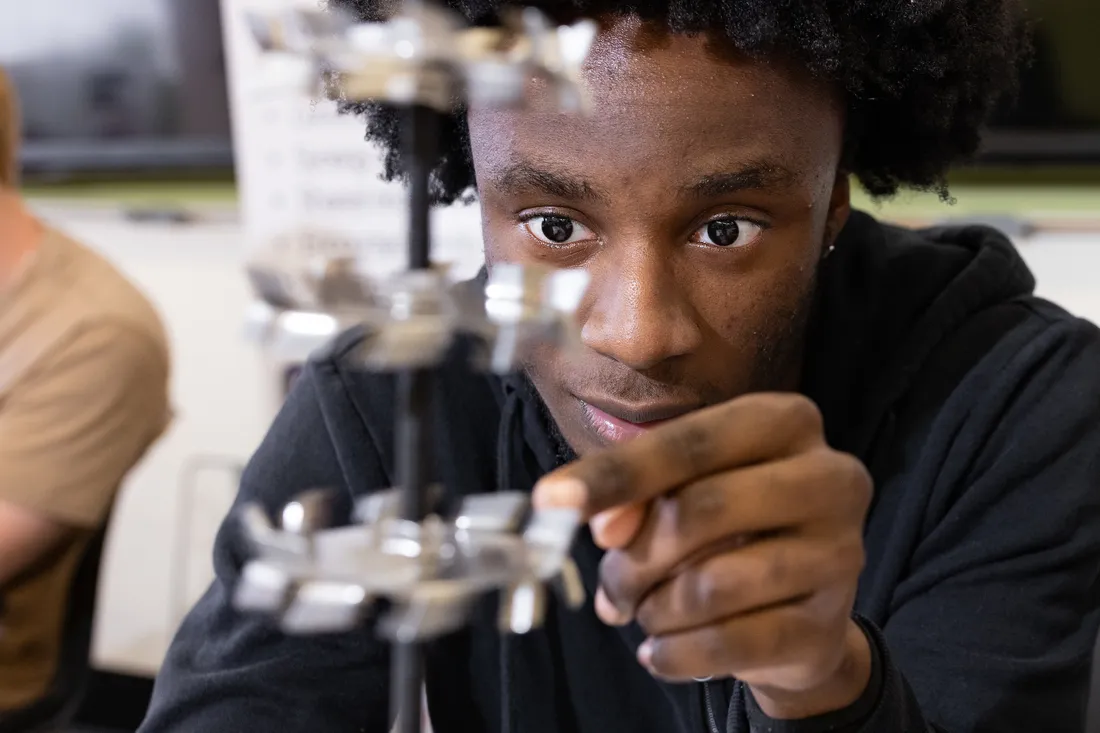
Professor Jonathan French worked with Zainab Kumandan ’22 researching how to make the general chemistry classroom a more inclusive environment with help from a Syracuse Office of Undergraduate Research and Creative Engagement grant.
Professor Jonathan French wants to ensure that all the students in his general chemistry course achieve success. “I enjoy helping students solve complex problems and seeing them make connections,” says the undergraduate director of chemistry in Syracuse University’s College of Arts and Sciences.
French began exploring options to increase classroom support and introduced innovative and inclusive initiatives to help students rise to their full potential. “General chemistry involves a lot of math and the best way I have found to help students with the calculations required is to practice,” he says. “I break up the lecture with sessions where students work on solving problems collaboratively.”
It is important to help retain first-generation and minority students in key introductory courses because that will in turn improve the diversity of people working in STEM fields.
Professor Jonathan French
Learning from Peers
French introduced a new approach to his classroom teaching—a learning assistant program with the support of a Howard Hughes Medical Institute CHANcE grant, which aims to create an inclusive environment for students from groups underrepresented in STEM. Nationally, French says, this is an important issue, noting that studies have shown first-generation and underrepresented students have a greater tendency than their peers to struggle in introductory STEM courses. “This has an impact on the resulting diversity, or lack of diversity, represented within STEM majors,” he says. “It is important to help retain first-generation and minority students in key introductory courses because that will in turn improve the diversity of people working in STEM fields.”
Through French’s program, upper-level Syracuse students who had successfully completed the 100-level general chemistry sequence returned to the class as assistants to support newer students. “With the learning assistants in the classroom, there are more helpers that the students can connect with during problem-solving sessions, more chances for the students to get help and have their question answered,” he says.

French began exploring options to increase classroom support and introduced innovative and inclusive initiatives to help students rise to their full potential.
French also taught a one-credit class for the assistants to prepare them to work effectively with the general chemistry students. “We had weekly readings and discussions designed to introduce the learning assistants to inclusive teaching practices that they could use when working with students,” he says.
French says that having them participate in the course is an important aspect of engagement. “The learning assistants better reflect the diversity of the student body, and students are also more likely to seek help from them, as they are closer in age,” he says. “Learning assistants are often better able to explain the material, having just recently mastered the content—they still remember the connections they needed to make and the challenges they faced when learning the new material.”
In addition to building connections between the general chemistry students and upper-level students within the University, the learning assistants offer advice to the students such as how to prepare for an exam. “The program helps engage those students at risk, improves the success rate in the course and helps students who were already going to succeed in the course do even better,” French says.
With the learning assistants in the classroom, there are more helpers that the students can connect with during problem-solving sessions, more chances for the students to get help and have their question answered.
Professor Jonathan French
Researching and Evaluating Support Methods
In 2020, French received a research assistant grant from the Syracuse Office of Undergraduate Research and Creative Engagement (SOURCE) as part of a pilot program that enabled faculty mentors to hire undergraduate assistants to work on their research projects.
“Part of our mission is to expand and deepen undergraduate research opportunities, as well as to get students involved in research at earlier stages in their academic career,” says Kate Hanson, director of undergraduate research at SOURCE. “With the research assistant grant program, the students develop their skills and learn about research and creative methods in the discipline, and the faculty mentors receive valuable assistance to move their work forward.”
French worked with Zainab Kumandan ’22, a biotechnology major in the College of Arts and Sciences, to study how the learning assistant program helps make the general chemistry classroom more inclusive for students. Kumandan had completed the general chemistry sequence and also participated in the first cohort of learning assistants.

“It doesn’t matter what your experience or background is—people collaborate and learn with you in a very welcoming environment,” Kumandan says.
“Professor French was one of my favorite professors and very supportive,” says Kumandan, who also minored in business management in the Martin J. Whitman School of Management. “The SOURCE grant had the potential to make an impact within the Syracuse University community, since this type of research has never been done before.”
Kumandan’s experience as a student in general chemistry and as a learning assistant gave her tremendous insight into the function of the program and how it could be improved. “Zainab was in a unique position—through observing 15 different learning assistants during their problem sessions, she was able to see 15 different methods of interacting with students,” French says. “She was quickly able to identify strategies that were working well for some learning assistants as well as areas of improvement for others.”
Kumandan’s observations enabled French to help the learning assistants address issues and improve students’ engagement. It was rewarding to help advance this research, she says. “The learning assistant program developed my confidence in my abilities and also in mentoring others.”
In spring 2021, each learning assistant was assigned a group of students to work with for the entire semester in weekly problem sessions over Zoom. The learning assistants collaboratively worked through a problem set that French designed for each week.
“There has been so much change over the last four semesters in the structure of the course and the mode of instruction—from transitioning to online, to an entire year online and now to be back in person,” French says. “The learning assistant program provided another point of connection between first-year and upper-level students at the University.”
The learning assistant program developed my confidence in my abilities and also in mentoring others.
Zainab Kumandan ’22
Looking to Scale
As part of the research, French surveyed the general chemistry students who participated in the program to gauge their achievements in the course as well as feeling of inclusion.
“The students reported a higher level of engagement at the University, a higher sense of belonging, and a slightly higher GPA,” French says.
Another conclusion of the surveys: “Learning assistants often facilitate discussions that are much more engaging and vibrant,” French says. “Students feel more comfortable working with learning assistants and asking them for help.”
French sees a potential to apply these findings more broadly throughout the University, considering the success of similar programs in biology and physics, which incorporate peer-led team learning and a coaching program, respectively. “The scale of the program could be increased to be available to all general chemistry students and eventually even applied to organic chemistry, the next chemistry course in the sequence, one that experiences similar issues of success rates,” he says. “General chemistry is a class that is required for a wide variety of studies, including engineering, health and exercise science, so the learning assistant program has an impact across campus.”


